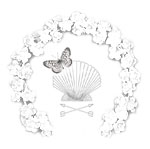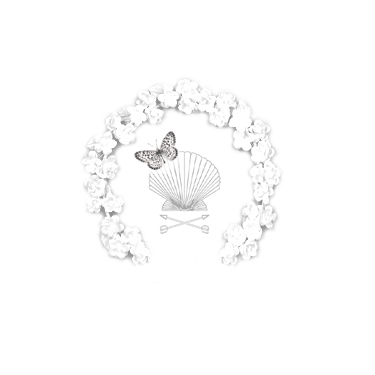
| Philosophy & Artist Statement. | Biography & A brief interview. | Iconography. | Portfolio Archive. | Art Shows & Schedule. |

Just as the Ancient Greeks did, Iconography is heavily used in my art:
| The Flowers- | The flowers I use foremost as an aesthetic element in my art, but it has also become somewhat of a visual signature. although it gives a tranquil feeling to the viewer, the wreath of flowers is also Voluptas's (Hedone) iconography. Hedone (Voluptas) was born of pure good, without hate or malice in her heart. Tender, caring, and loving, her father was Eros, the god of Love, and her mother was Psyche, the deification the soul. Which you can now perhaps get an understanding of the next iconography; |
| The Sea Shells- | The sea shells and 'Nautical' elements represent Aphrodite, The Sea and its life giving resources. They are aesthetic elements, but at the same time hold significance. |
| The Arrows & The Butterflies- | The arrows represent Eros, the butterflies represent Psyche. Arrows being the iconography of Eros, represent a sense of calmness and tranquility, which is one of the main tenets of what I wish to convey with my art. The butterflies, although decorative and aesthetic, it gives a connection to nature and the natural world, but still again it holds significance; Psyche being the deification of the soul, it is a visual reference to Summerland. |
| The Flowerpots- | The flowerpots are like a vessel, symbolically it represents the womb, the earth being like a womb from which life grows fourth, it also represents mother nature. However again, it is also functional; acting as a structural support for standing figurative sculptures, in much the same way an oak tree was used in marble carvings in Ancient Greece. |
On a more personal level:
| The eyelashes & The Shoes- | I implement these a lot in my art. I was once told it gives my sculptures a very 'mademoiselle' Victorian feel; that is partially correct, the point again is beauty. There are several objectives, but the underlying point is simply 'beauty'. Making art that gives a sense of tranquility to the viewer. (This again, as explained in another part of the website, is why I shy away from rough, jagged surfaces, preferring rounded, soft forms.) On a personal level, as an artist, as a sculptor, it is ironic that in order to 'create beauty' you yourself in the process become 'less than beautiful'. It is only one day a week that I truly feel 'beautiful'. So you can understand then the shoes represent for me a sense of cleanliness, which ultimately is 'beauty'. Beauty is Tranquility. And again, that is the ultimate underlying point, in much the same manner the Neoclassicists, Baroque, as well as Art Nouveau salon explored The Golden age of Ancient Greece-A sense of innocence & Rebirth. A return to better, simpler, idealized times. |
| The lack of body hair- | Now there's one, that no matter when and where, someone's always going to have something to say. My response is two things; 1.) In ancient times, body hair, or a lack thereof, was a sign of cleanliness. 'Waxing', or hair depletion, ironically enough, began as a predominately 'male' thing to do as far as personal grooming is concerned. That's not to say that hair depletion was also done for hygienic reasons, the Egyptians went as far as shaving their heads and wearing wigs for hygienic reasons, which then became the fashionable thing to do. Cleanliness and spirituality were complimentary, if not inseparable. However, 2.) On a more aesthetic level, I don't include body hair because my feeling is that it interrupts the flow of the form. |